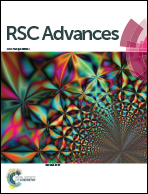Study of binding interactions between MPT63 protein and Au nanocluster†
Abstract
The use of protein–nanocluster conjugates in the field of bio-nanotechnology provides exciting opportunities in live cell imaging, drug delivery and detecting pathogens. Here, we have demonstrated the interactions between Mycobacterium tuberculosis derived protein MPT63 and gold nanoclusters (Au NCs). Two single cysteine mutants of MPT63, namely G20C and G75C have been used to study the position dependence of cysteine residues on nanocluster–protein interactions. In the presence of MPT63, the enhancement of fluorescence intensity and the decay time of the Au nanocluster confirm the binding of MPT63 to Au NC. The decrease in non-radiative relaxation of Au NC by solvent molecules inside the protein environment might be responsible for the increase in fluorescence intensity and decay time of Au NC. The determination of the binding constant for protein–Au NC complex reveals the difference in binding ability of wild type MPT63 and its two cysteine mutants. We have also studied the effects of pH and salt on protein–Au NC interactions. Based on these results, it is suggested that both electrostatics and other factors play crucial roles to define the complexity of protein–Au NC interactions.


 Please wait while we load your content...
Please wait while we load your content...